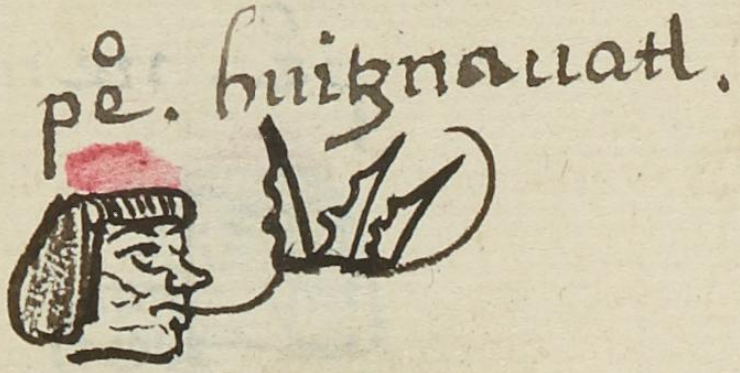Huitznahuatl (MH677r)
This black-line drawing of the compound glyph for the personal name or title, Huitznahuatl (something like mandón or alguacil in Spanish as shown in the Codex Mendoza, but it was also a famous name) is attested here as a man’s name. The glyph shows a frontal view of three thorny (pointing to huitztli) branches from an agave plant. To the right of these branches is a curving line that gives the suggestion of a volute, possibly intending a phonetic indicator for the -nahuatl (language, speech) ending to the name. Also possible is that multiple thorns have been placed near (-nahuac) each other as a phonetic indicator.
Stephanie Wood
John Bierhorst (A Nahuatl-English Dictionary and Concordance to the Cantares Mexicanos, 1985, 143) says that Huitznahuatl was a "name or epithet of a god to whom slaves were sacrificed in Mexico." Other sources report that one of the ethnic groups that migrated from the Seven Caves came from a place called Huitznahuac, and there was a temple with this association in Mexico Tenochtitlan. Finally, Huitznahuatl was a high title, and it had an association with the South. The name was not inaccessible for tribute-paying men of humble means, such as found in the census of modern-day Morelos and in the Matrícula de Huexotzinco (modern-day Puebla). See the Online Nahuatl Dictionary for more information about Huitznahuac and Huitznahuatl, and see some examples of other glyphs, below, for making comparisons.
Stephanie Wood
1560
Jeff Haskett-Wood
agaves, pencas, espinas, lenguaje, idiomas, hablar, nombres famosos, nombres de hombres

Huitznahuatl, a lordly title, perhaps an occupation, and the name of a ruler, https://nahuatl.wired-humanities.org/content/huitznahuatl
Huitznahuac, a place, a calpolli from Chicomoztoc, an ethnicity, warrior-dancers, https://nahuatl.wired-humanities.org/content/huitznahuac
-catl, affiliation suffix, https://nahuatl.wired-humanities.org/content/catl
huitz(tli), a thorn or spine, https://nahuatl.wired-humanities.org/content/huitztli
-nahuac, next to, https://nahuatl.wired-humanities.org/content/nahuac
nahua(tl), language, https://nahuatl.wired-humanities.org/content/nahuatl
(un título, o un oficio)
Stephanie Wood
Matrícula de Huexotzinco, folio 677r, World Digital Library, https://www.loc.gov/resource/gdcwdl.wdl_15282/?sp=434&st=image.
This manuscript is hosted by the Library of Congress and the World Digital Library; used here with the Creative Commons, “Attribution-NonCommercial-ShareAlike 3.0 License” (CC-BY-NC-SAq 3.0).










